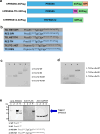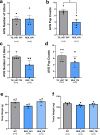Rescue of male infertility by human PRSS55 in transgenic mice establishes a contraceptive research model
- PMID: 40764777
- PMCID: PMC12325665
- DOI: 10.1038/s41598-025-09604-9
Rescue of male infertility by human PRSS55 in transgenic mice establishes a contraceptive research model
Abstract
The development of non-hormonal male contraceptives requires validated preclinical models. This study investigated whether human orthologs of two mouse testis-specific serine proteases, PRSS55 and TMPRSS12, both essential for male fertility in mice, could functionally rescue the infertility phenotypes of their respective knockout mouse lines. We generated transgenic mouse lines expressing human PRSS55 with either an extracellularly or intracellularly positioned C-terminal 3xFLAG tag (RES GPI or RES TM), and a line expressing human TMPRSS12 with a C-terminal 3xFLAG tag (T12 RES), all on their respective mouse null backgrounds. Fertility was assessed through continuous mating trials, and sperm parameters were evaluated. Both hPRSS55 rescue lines sired offspring; RES GPI males exhibited partially restored fertility with significantly fewer pups per litter compared to controls, while RES TM males demonstrated fertility comparable to controls. In contrast, T12 RES males remained infertile, exhibiting severe defects in sperm motility and other parameters, despite confirmed transgene mRNA expression. These findings indicate that human PRSS55, particularly when tagged intracellularly, can functionally replace its mouse counterpart, validating the RES TM line as a promising model for testing human PRSS55-targeted contraceptives. The inability of hTMPRSS12 to rescue fertility highlights challenges potentially due to sequence divergence or unconfirmed protein expression levels.
© 2025. The Author(s).
Conflict of interest statement
Declarations. Competing interests: The authors declare no competing interests.
Figures






Similar articles
-
Antioxidants for male subfertility.Cochrane Database Syst Rev. 2014;(12):CD007411. doi: 10.1002/14651858.CD007411.pub3. Epub 2014 Dec 15. Cochrane Database Syst Rev. 2014. Update in: Cochrane Database Syst Rev. 2019 Mar 14;3:CD007411. doi: 10.1002/14651858.CD007411.pub4. PMID: 25504418 Updated.
-
CCDC89 is required for optimal sperm motility and male fertility in mammals.Hum Reprod. 2025 Jul 1:deaf126. doi: 10.1093/humrep/deaf126. Online ahead of print. Hum Reprod. 2025. PMID: 40591933
-
Drosophila seminal sex peptide associates with rival as well as own sperm, providing SP function in polyandrous females.Elife. 2020 Jul 16;9:e58322. doi: 10.7554/eLife.58322. Elife. 2020. PMID: 32672537 Free PMC article.
-
A subset of evolutionarily conserved centriolar satellite core components is crucial for sperm flagellum biogenesis.Theranostics. 2025 Jun 12;15(14):7025-7044. doi: 10.7150/thno.117118. eCollection 2025. Theranostics. 2025. PMID: 40585997 Free PMC article.
-
Antioxidants for male subfertility.Cochrane Database Syst Rev. 2022 May 4;5(5):CD007411. doi: 10.1002/14651858.CD007411.pub5. Cochrane Database Syst Rev. 2022. PMID: 35506389 Free PMC article.
References
MeSH terms
Substances
Grants and funding
- HD098069/Eunice Kennedy Shriver National Institute of Child Health and Human Development
- HD088412/Eunice Kennedy Shriver National Institute of Child Health and Human Development
- HD088412/Eunice Kennedy Shriver National Institute of Child Health and Human Development
- HD088412/Eunice Kennedy Shriver National Institute of Child Health and Human Development
- INV-001902/GATES/Gates Foundation/United States
LinkOut - more resources
Full Text Sources
Medical

